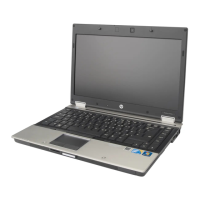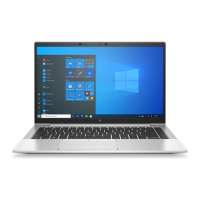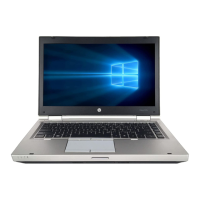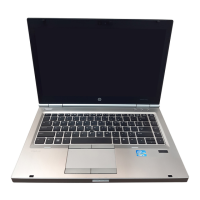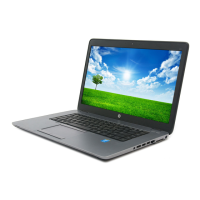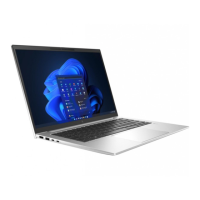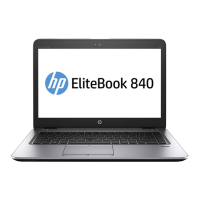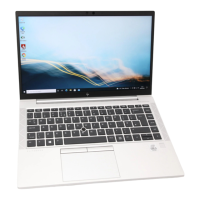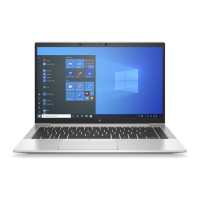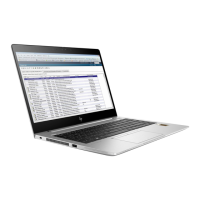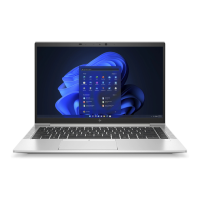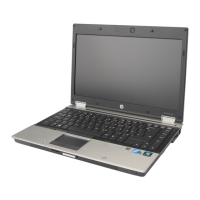
Do you have a question about the HP EliteBook 8440P and is the answer not in the manual?
| HDD speed | 7200 RPM |
|---|---|
| HDD interface | SATA II |
| Card reader integrated | Yes |
| Total storage capacity | 500 GB |
| Compatible memory cards | MMC, SD |
| Operating temperature (T-T) | 5 - 35 °C |
| Storage relative humidity (H-H) | 5 - 95 % |
| Operating relative humidity (H-H) | 10 - 90 % |
| Memory slots | 2x SO-DIMM |
| Internal memory | 4 GB |
| Memory clock speed | 1333 MHz |
| Internal memory type | DDR3-SDRAM |
| Maximum internal memory | 8 GB |
| Bus type | DMI |
| Stepping | C2 |
| Tjunction | 105 °C |
| Processor cache | 4 MB |
| Processor cores | 2 |
| Processor model | i7-620M |
| System bus rate | 2.5 GT/s |
| Processor family | Intel® Core™ i7 |
| Processor series | Intel Core i7-600 Mobile Series |
| Processor socket | BGA 1288 |
| Processor threads | 4 |
| Processor codename | Arrandale |
| Processing Die size | 81 mm² |
| Processor frequency | 2.66 GHz |
| Processor cache type | Smart Cache |
| Processor lithography | 32 nm |
| Processor manufacturer | Intel |
| PCI Express slots version | 2.0 |
| Processor boost frequency | 3.33 GHz |
| Processor operating modes | 64-bit |
| ECC supported by processor | No |
| PCI Express configurations | 1x16 |
| Thermal Design Power (TDP) | 35 W |
| CPU multiplier (bus/core ratio) | 20 |
| Maximum number of PCI Express lanes | 16 |
| Number of Processing Die Transistors | 382 M |
| Motherboard chipset | Intel® QM57 Express |
| Display diagonal | 14 \ |
| Display resolution | 1600 x 900 pixels |
| Native aspect ratio | 16:9 |
| Discrete graphics card model | NVIDIA Quadro HD 6310 |
| Maximum graphics card memory | - GB |
| On-board graphics card model | Intel® HD Graphics |
| Discrete graphics card memory | 0.512 GB |
| On-board graphics card base frequency | 500 MHz |
| On-board graphics card dynamic frequency (max) | 766 MHz |
| Type | PC |
| Graphics card family | NVIDIA |
| Intel segment tagging | Enterprise |
| Audio system | HP Premier Sound |
| Bluetooth version | 2.1+EDR |
| Networking features | Gigabit Ethernet |
| Mobile network generation | 3G |
| Operating system installed | Windows 7 Professional |
| Number of battery cells | 6 |
| Charging port type | DC-in jack |
| Serial ports quantity | - |
| USB 2.0 ports quantity | 3 |
| CardBus PCMCIA slots quantity | 0 |
| Cable lock slot type | Kensington |
| Product color | Silver |
| Country of origin | China |
| Keyboard layout | QWERTY |
| Pointing device | Touchpad |
| Processor code | SLBPE |
| Processor ARK ID | 43560 |
| Processor package size | rPGA 37.5x 37.5, BGA 34x28 mm |
| Graphics & IMC lithography | 45 nm |
| Supported instruction sets | SSE4.1/4.2 |
| Intel® Turbo Boost Technology | 1.0 |
| Physical Address Extension (PAE) | 36 bit |
| Depth | 236 mm |
|---|---|
| Width | 336 mm |
| Weight | 2120 g |
| Height (front) | 31 mm |
Details on identifying the computer's hardware components and their functions.
Guide to using wireless devices like WLAN, WWAN, and Bluetooth.
Details on accessing and managing WLANs.
Information on using HP Mobile Broadband for internet access.
Solutions for common wireless connectivity issues.
Instructions for connecting and using the computer's modem.
Instructions for connecting to a wired network using an Ethernet cable.
Information and procedures related to the computer's audio functions.
Information and procedures related to the computer's video capabilities.
Information and procedures for using the computer's optical drive.
Information and procedures for using the integrated webcam.
Configuring power-saving states and options for the computer.
Tools for optimizing power consumption and battery life.
Actions to take when the battery level is low or critical.
Procedures for testing the AC adapter's functionality.
Methods to optimize hard drive efficiency.
Procedure for replacing the internal hard drive.
Instructions for replacing drives in the computer's upgrade bay.
Procedure for removing and installing a hard drive in the upgrade bay.
Procedure for replacing the optical drive in the upgrade bay.
Connecting and using external USB devices.
Instructions for connecting and using IEEE 1394 devices.
Instructions for upgrading RAM in the expansion slot.
Instructions for upgrading RAM in the primary slot under the keyboard.
Overview of security features to protect the computer and data.
Guidance on creating, saving, and managing passwords.
How to set administrator and user passwords in Windows.
Setting BIOS administrator and DriveLock passwords.
Details about the BIOS administrator password and its characteristics.
Steps to set, change, or delete the BIOS administrator password.
How to enter the BIOS administrator password when prompted.
Information and considerations for using DriveLock protection.
Procedure to set DriveLock user and master passwords.
How to enter the DriveLock password to access the protected drive.
Steps to modify an existing DriveLock password.
Procedure to disable or remove DriveLock protection.
Setting up automatic DriveLock passwords for multi-user environments.
Configuring security settings for various system devices.
Protecting the computer from viruses using antivirus software.
Protecting privacy and data using firewall software.
Importance and procedure for installing critical security updates.
Overview of HP ProtectTools Security Manager features.
Procedures for updating system software and drivers.
Determining BIOS version and updating the BIOS.
How to check the current BIOS version.
Steps to download BIOS updates from the HP website.
How to update software and drivers from the HP website.
Using SDM to search, download, and install HP SoftPaqs.
Methods for backing up files, folders, and system images.
Tools and procedures for recovering data and the operating system.
Using Windows Backup and Startup Repair for recovery.
Using f11 to recover the original hard drive image.
Recovery procedure using a Windows 7 OS DVD.
How to access the computer's BIOS setup utility.
Navigating and interacting within the Computer Setup utility.
Steps to reset Computer Setup to original factory defaults.
Description of security-related options in Computer Setup.
Explanation of how the system selects boot devices and their order.
How to enable USB, NIC, and other devices for booting.
Ways to manage boot order and startup prompts.
Steps to set a permanent boot device order.
Overview of solutions for managing client computers in a network.
Methods for deploying customized software images to computers.
Tools and processes for managing and updating client software.
